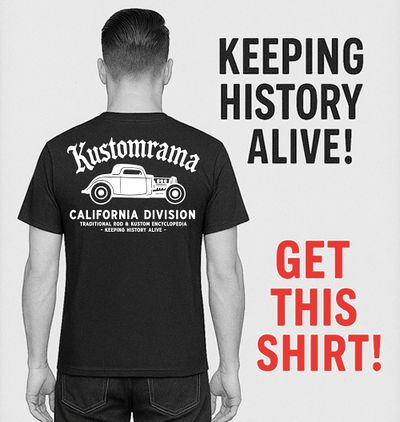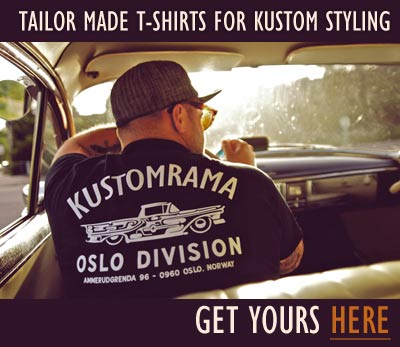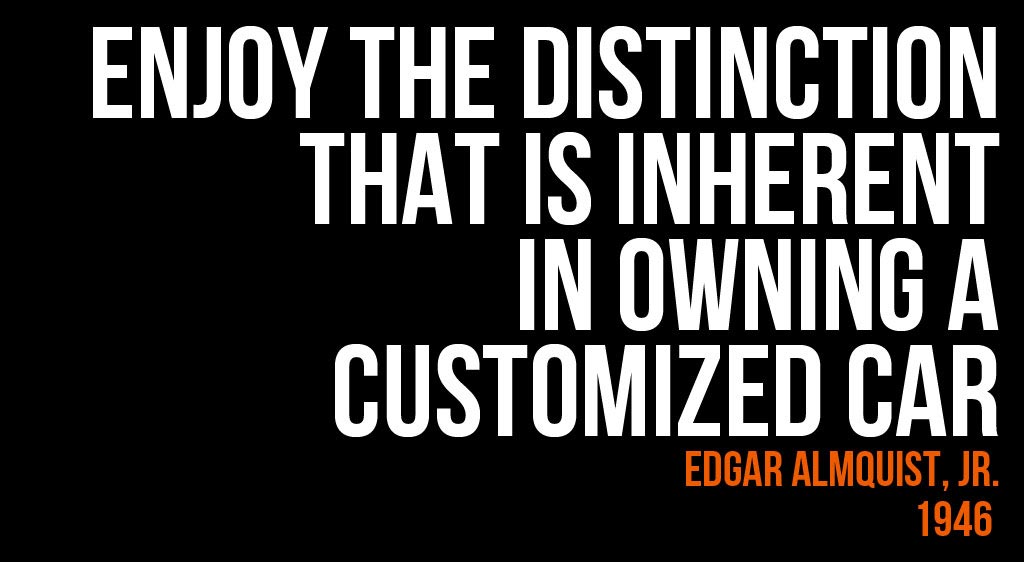Buzz Pitzen's 1929 Ford
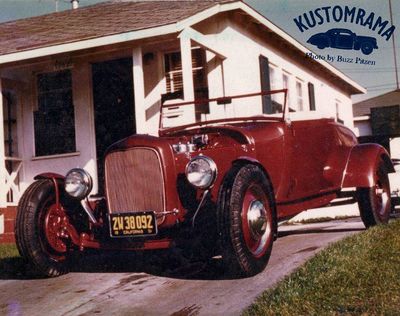








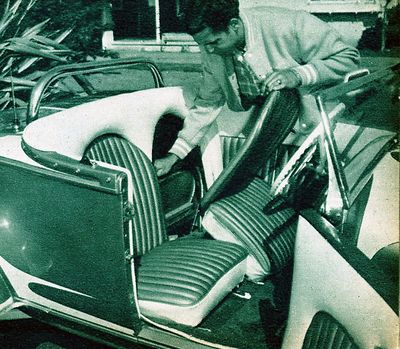


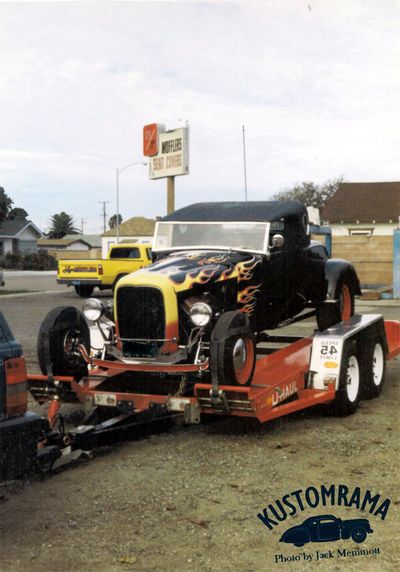




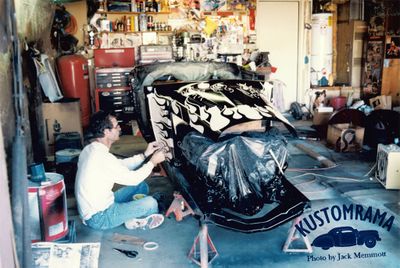








1929 Ford Model A roadster owned and built by Challengers of Los Angeles member Buzz Pitzen of Los Angeles, California. The roadster was Buzz' first hot rod, and he started building it around 1954. In 2013 he couldn't remember exactly when he bought it. He knew he got married when he was twenty, in 1954, and he knew that he bought the car before he turned 21.[1] Buzz bought the roadster as a rolling frame and body from a guy that had started to build it into a hot rod. It was a rust free stock body, and the frame had all fender braces removed and filled. It came without a motor, transmission and wiring. Buzz worked a second job at a local gas station at the time to make ends meet. He was making $95 a week, and he had to pay $150 for the roadster, so it was a struggle for him. Buzz parked the roadster in front of his apartment, and started to work on it there. He bought and installed a 1948 Mercury flathead in the car. The engine displaced 296 cu. inches running a three pot Navarro manifold, Sharp heads, a Howard cam, and converted Zephyr dual ignition. It was dressed up featuring a chromed alternator and transparent red fuel lines. The column transmission featured Zephyr gears. Drilled-out hydraulic brakes from a 1940 Ford were installed up front, while a 1939 Ford rear end with a 4.44-1 ratio was installed in the rear of the car. The frame horns were cut off, before Buzz installed a suicide front suspension, or a "bulldog suspension", as they called it back then. A filled and sectioned grille shell, made from two 1932 Ford grille shells, was installed along with a louvered hood. An antenna was used to mount the front license plate. The headlight mounts were cast aluminum aftermarket parts. Motorcycle type fenders were installed up front, while the rear fenders were bobbed. The cowl was filled and the windshield was chopped. Inside, a reversed 1932 Ford dash was molded into the cowl. According to Hot Rod Magazine March 1959, the dash was fit with a Stewart-Warner marine panel and Stewart-Warner instruments. Next owner, John Rasmussen, claims that the car was fit with an Auburn dash when he bought it, and not a Stewart Warner Marine Panel. The interior featured individual bucket seats that could be tilted forward to provide access to the battery box and electric fuel pump. The interior and trunk were upholstered in blue and white Naugahyde by Los Angeles upholsterer Jack McNeil. A 1955 Ford Thunderbird steering wheel was installed along with a chromed roll bar. The functional roll bar qualified the roadster to drag. An antenna was installed behind the roll bar on the passenger side. Two exhaust pipes extruded trough the panel underneath the deck lid.[2] Once the bodywork was completed, Buzz painted the roadster Maroon. He was not fond of the color, so as the build evolved he painted it Bahama Blue with White scallops. Red flames were added behind each row of louvers by a local pinstriper. Not found of the color, Buzz repainted them white and had them re-striped.[1]
The build was completed in 1959. Shortly after he had completed it, he sold it to Barons of Westchester member John Rasmussen of Westchester, California. Buzz sold the roadster so he could buy his first home in Redondo Beach, California. After John bought it, the roadster was featured on the cover of Hot Rod March 1959. This version featured full Moon discs that John had installed. After selling the Model A, Buzz started to build a fiberglass bodied 1923 Ford Model T Roadster.[1]
The 1929 roadster was also featured in the Car Craft June 1960 magazine cover story "Return of the Roadsters", then John Rasmussen had a fire in the car, and he repainted it a Maroon color called Tunisian Red. He also had the upholstery redone by Jack McNeil. After the fire, John also hand built a fiberglass removable hardtop with "T Bird Portholes." In the quest for more speed, John built his first of many racing engines, that he installed in the roadster with a big block drivetrain in the early 1960s. The engine was a crate 1959/1960 Oldsmobile 394 that he bought new for the princely sum of $613.80 from Albertson's Oldsmobile. The engine was complete, including a bell housing, clutch, generator and starter, and when John got it home he fired it up in the crate. It was built up hot rod style by John, and it featured an Engel 142 cam, six Rochester carburetors on a log manifold, and a Dual Coil Rotofase ignition. John also experimented with various drivetrains, starting with a 1937 Buick, 1937 LaSalle, before finally settling on a 1953 Slant Pan B&M Hydro stick. John had a 1950 Oldsmobile rear end of various gear ratios, depending on upon the race. He had Donovan Engineering of Inglewood narrow it 10 inches and install shortened 1960 Oldsmobile axels to fit his original magnesium American Torque Thrusts wheels and the M&H racing slicks. The radius rods were hand built using 1935 - 1936 Ford wishbones. John also hand built the headers himself with cut outs.[3]
Now a 12 second car, this combination was a very successful 1960s street racer. John tells of some significant wins in the Southern California street racing scene. The most notable race he recalls half the Valley saw, was being called out by his friends and competitors Don Prudhomme and Skip Torgerson as they cruised Bob’s Big Boy in their 1957 or 1958 Cadillac. He was called on to race Skip’s full-on drag bike, not street legal. Don push started Skip’s bike, Skip recalls that John got him out of the gate and blew off the bike. John also recalls a famous race against the ominous Tom McMullin's 1932 Ford roadster, with its Roots Supercharged blown small block Chevy out of Harvey’s Broiler in Downey, California. John’s ’29 with the Olds and six deuces beat the McMullin roadster hands down. John quips “A lot of people saw that race!” One last event John recalls as “the most memorable” was when he was parked with a gal in the oil fields above the Los Angeles freeway, as we old guys would say “trying to make time”. Hearing a race going on, John decided to investigate it. A 1955 Chevrolet was about to be awarded a 2 foot trophy for eliminating everyone when John drove up. John blew the doors off the Chevy and, being a “gentleman”, John’s date got the trophy.[3]
John Rasmussen became a member of the Los Angeles fire department. Though he never got a speeding ticket in the car, his new career would not allow that ominous "Exhibition of Speed" conviction, so this ended John's street racing career. John kept the roadster for many years, but decided to sell it to focus on legal drag racing. John became a well known Southern California drag racer running Top Fuel/Gas dragsters, competing with the likes of Tommy Ivo and Don Prudhomme. In October of 2013 John was included into the NHRA Drag Racing Hall of Fame for his exploits in Top Fuel/Gas, being known as a builder and driver of an infamous twin engine dragster that match raced the “Freight Train” twin engine dragster. He was well known for the Beacon Auto/Hydro Head Machine Shop dragster holding the title of the Worlds Quickest Top Fuel with a time of 7.42, and eventually as the quickest (7.38) and fastest dragster in Top Gas. John won 39 straight races with that car. However, he was also famous as the owner of his famed 1929 roadster with coverage of his NRHA Drag Racing Hall of Fame inauguration picturing the famous Hot Rod March 1959 magazine cover and quoting: “John also loved street rods and his car was so nice that it was on the cover of Hot Rod Magazine in 1959, and he didn’t even have to win a race to get on the cover!”[3]
Jack Memmott of Bay City, California bought the old hot rod the day after Christmas in 1994, after picking up a Ford Trader on Christmas Eve. The car was located in Lompoc, California at the time, so after he had hustled everyone out of the house after Christmas dinner, Jack and his wife left for Lompoc the same day. The next day he saw the roadster from 1/4 mile away, and he told his wife "I think we have found our hot rod". It was for sale by Mike McVicar of Jeffers Muffler Service. Mike told Jack that he had bought the car out of years of storage. Mike redid the brakes and fluids before he got it running. He showed Jack the underside of the car on his lift, and Jack was amazed at what he saw. It was so clean that it looked like it came right off the showroom. Mike sold the car so he could help his kid with college tuition. A deal was made, and Jack became the new caretaker of the old historic hot rod.[4]
When Jack bought the roadster the body had a 1960s period paint job, black with flames and pinstriping. Other that that, it was just as Buzz Pitzen/John Rasmussen built it. It also came with the original fiberglass T Bird Porthole hardtop that John had made for it. The configuration of the car was period perfect early 1960s, and it even rolled on 1940 Ford wheels with Casler Cheater Slicks from the 1950s. Jack traded Mike a deer rifle for the four original 1950s drag racing magnesium American Torque Thrust wheels John ran on the hot rod in the 1960s. It came with a Holley four barrel on a stock manifold, Jack switched to a period Weiand manifold, which he hand polished, and two Carter AFBs. Had he known their history, Jack could have bought the original six deuce set up for another $500, but he decided to pass.[4]
Jack drove the car to many rod events in Northern California until 1999, when he decided to restore it back to its then current 1960s configuration. The body, engine and frame were stripped by Jack and his wife Candace in their two car garage. The body was not lifted from the frame during the restoration, as it was free for rust, and the rollbar was welded to the floor and frame. Jack and his wife did everything on the car during the restoration, except for the chrome, interior and pinstriping. Jack stenciled the original flame job on the car, so he could duplicate it perfectly after the restoration. The flames he put on the old Pitzen/Rasmussen roadster was in fact his first flame job. Ralph Finley, a founding member of the Swanx of Vallejo car club, pinstriped the flames afterward. During the restoration, Jack decided to change the color of the upholstery. It was all black when he got it, but the original white surroundings were found underneath the black upholstery, so he decided to go with the same scheme as the 1959 cover car, but in black and red instead. The trunk was upholstered similar to the 1959 configuration as well. The upholstery work was done by Ron Giovacchini and his dad at Dante's Modern Auto Top. Ron's Dad, who was in his 80s at the time ,started the shop back in the 1940s. The chrome was plated by Delta Plating. The restored version was fit with two new Carter four barrel carburetors, a Griffin radiator and a 7 inch fan. He kept the modified 32 radiator and the chromed fan so he can build it back to how it sat in the 1960s, which was how he bought it in 1994.[4]
The first time out, Jack and Candace won the Righteous Roadster Award at a Goodguys show. Pat Ganahl attended the show, and Jack remembers how he complemented Jack and Candace on the "period perfect" restoration. In November of 2001 Rod & Custom Magazine named and pictured Jack's roadster as one of "The 10 Best Forgotten Hot Rods" in the United States.[4]
Jack still owned the roadster in 2014, and he told Kustomrama that it is a keeper that reeks of hot rod history. Jack has been told countless stories of rides in the early 1960s including winning a street drag against the McMullin roadster, a tale of the toilet roll oil filter flying off in a drag against a GTO, and John's famous burn out exit from his WEstchester High graduation. Pat Ganahl told Jack that John Rasmussen parked it behind the bleachers at his high school graduation. After the the graduation he ran to the car and jumped over the door. As he burned out of the parking lot he threw off his hat. John’s comment about what happened some 50 years ago…”Well, makes for a good story."[4]
Magazine Features
Hot Rod Magazine March 1959
Car Craft June 1960
Rod & Custom November 2001
Hop Up 1
Hot Rod Deluxe May 2011
Hot Rod Deluxe Special Edition November 2011
References
Did you enjoy this article?
Kustomrama is an encyclopedia dedicated to preserve, share and protect traditional hot rod and custom car history from all over the world.
- Help us keep history alive. For as little as 2.99 USD a month you can become a monthly supporter. Click here to learn more.
- Subscribe to our free newsletter and receive regular updates and stories from Kustomrama.
- Do you know someone who would enjoy this article? Click here to forward it.
Can you help us make this article better?
Please get in touch with us at mail@kustomrama.com if you have additional information or photos to share about Buzz Pitzen's 1929 Ford.
This article was made possible by:
SunTec Auto Glass - Auto Glass Services on Vintage and Classic Cars
Finding a replacement windshield, back or side glass can be a difficult task when restoring your vintage or custom classic car. It doesn't have to be though now with auto glass specialist companies like www.suntecautoglass.com. They can source OEM or OEM-equivalent glass for older makes/models; which will ensure a proper fit every time. Check them out for more details!
Do you want to see your company here? Click here for more info about how you can advertise your business on Kustomrama.





